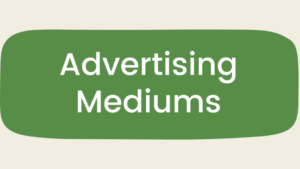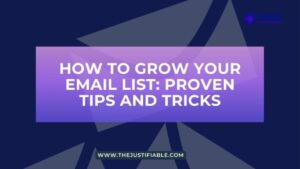Do you want to make a blog for money but wonder how to get started in as little as 30 days? How can you turn a hobby into a profitable venture, and what steps are necessary to start seeing earnings quickly?
This guide will walk you through the essential strategies, tools, and tips to create a blog that not only grows traffic but also generates income within your first month. From niche selection to content creation and monetization, we cover everything you need to know to achieve blogging success.
Proven Steps To Make A Blog For Money In 30 Days
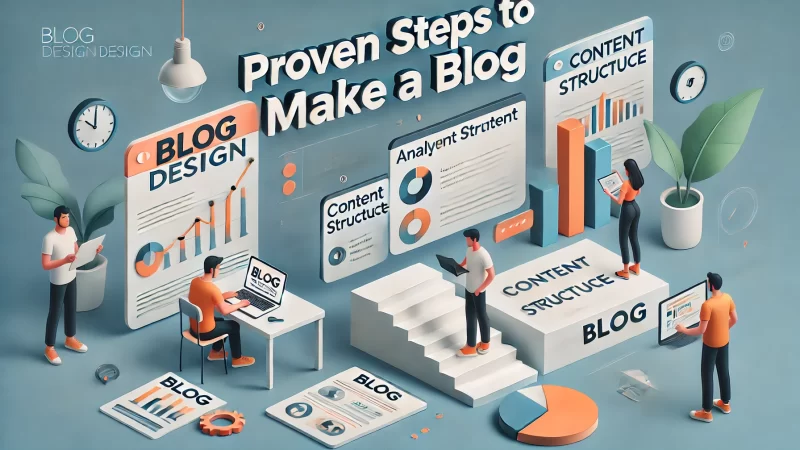
Starting a blog with the intention of making money can be exciting, but it requires strategic planning. I suggest focusing on clear, actionable steps to get your blog up and running quickly. Within 30 days, you can create a blog that not only attracts visitors but also generates income through monetization strategies. The key is to take deliberate actions right from the start.
Consistency and discipline are essential in this process. By choosing the right niche, identifying your target audience, and crafting quality content, you can position your blog for success. It’s crucial to invest time in keyword research and competitor analysis to avoid mistakes that could delay your progress.
How To Choose A Profitable Blog Niche
Choosing the right niche is perhaps the most critical decision when creating a blog to make money. I recommend selecting a niche you’re passionate about, but also one that has a proven audience. You don’t want to target a niche that is too broad, or else it becomes difficult to compete with established players in the space.
Another crucial factor is profitability. I advise you to analyze potential earnings by looking at the available monetization opportunities within that niche. Ask yourself whether affiliate programs, advertising, or digital products are viable in that area. You’ll also want to check for high demand and low competition for your chosen niche.
I find that narrowing your niche further increases your chances of success. For instance, instead of blogging about fitness, you might focus on fitness for busy moms or low-impact workouts for seniors. These are targeted, specific niches where audiences are looking for expert advice and are more likely to engage.
Choosing a niche with longevity is essential. Avoid “fad” niches that may only be popular for a short time. Instead, focus on niches that offer consistent interest over time, ensuring your blog continues generating income for the long haul. Sustainable niches build lasting communities and encourage steady traffic growth.
Consider your personal strengths when selecting a niche. I know that having a genuine interest in your topic can make content creation easier and more enjoyable, which is vital for maintaining the motivation required to grow your blog. When you write with passion and expertise, it shows—and that attracts loyal readers.
Identifying Your Audience For Maximum Earnings
Understanding your audience is pivotal in monetizing your blog successfully. I recommend you start by defining the demographics of your ideal reader. Are they young professionals, stay-at-home parents, or retirees? This helps you tailor your content and marketing strategies to appeal to their specific needs.
It’s also important to dive into the psychographics of your audience—what are their pain points, desires, and motivations? By tapping into what they care about most, you can create content that resonates on a deeper level, increasing engagement and ultimately boosting conversions. Knowing your audience allows you to provide the solutions they are actively seeking.
I’ve noticed that once you clearly define your audience, you can also more effectively choose affiliate programs and products that will be relevant and valuable to them. I advise against promoting products that don’t align with your audience’s needs, as this can hurt your credibility and diminish trust.
One of the most valuable methods I’ve found for identifying your audience is through surveys and polls. Ask your readers directly what they want to see on your blog and how you can help them. This kind of interaction not only provides insights but also builds a stronger community around your blog.
I also suggest you track your audience data through tools like Google Analytics. This allows you to monitor who is visiting your blog, what content they enjoy most, and where your traffic is coming from. By analyzing this data, you can refine your content strategy and improve your blog’s profitability over time.
Why You Should Research Competitors Before Launching
I believe competitor research is a crucial, often overlooked step when building a money-making blog. It helps you see what works in your niche and what doesn’t, allowing you to avoid common pitfalls. Analyzing competitors helps you understand the standards in your industry and ensures your blog stands out.
Look closely at your competitors’ content, and see which topics attract the most engagement. I’ve found that successful blogs in competitive niches often feature in-depth articles on evergreen topics. By producing similar, but more comprehensive and unique content, you can carve out your space in the market.
I recommend also analyzing their monetization strategies. Are they primarily using affiliate marketing, selling digital products, or focusing on ads? Understanding how your competitors are earning money can give you ideas on how to monetize your blog effectively.
One mistake I’ve seen is copying competitors without adding value. I suggest you find ways to differentiate yourself. Whether it’s through a more engaging writing style, better visuals, or a different content approach, standing out from the crowd is key to long-term success in blogging.
I also advise checking out your competitors’ backlink profiles. By using tools like Ahrefs or SEMrush, you can see which websites link to them and consider how to replicate or improve on those partnerships. Building a strong backlink profile helps with search engine rankings, driving more traffic to your blog.
How To Find High-Search, Low-Competition Keywords
Finding the right keywords can make or break your blog’s success. I’ve found that focusing on high-search, low-competition keywords is an excellent way to gain visibility without competing with large, established blogs. These keywords provide an easier path to rank higher in search engines, driving organic traffic.
I suggest starting with a keyword research tool like SEOPowersuite or Ubersuggest. Input topics related to your niche and look for long-tail keywords—phrases that are longer and more specific, which usually have lower competition. I’ve noticed these often convert better as they target users further down the purchasing funnel.
Once you have a list of potential keywords, analyze their search volumes. I recommend choosing keywords that have decent search volume but aren’t overly competitive. Aim for keywords that have searches in the range of 500 to 5,000 monthly. These are often more attainable and still bring valuable traffic to your blog.
It’s crucial to optimize your blog content with these keywords naturally. I emphasize that you should never force keywords into your writing. Instead, weave them into your content where they make sense and provide value. Keyword stuffing can harm your SEO and readability.
Lastly, I suggest regularly updating your keyword research. Trends change, and staying on top of evolving search behaviors can give you a competitive advantage. I’ve found that by staying agile with your SEO strategy, you can maintain or even improve your blog’s rankings over time.
Essential Tools For Building A Money-Making Blog

The tools you use can significantly impact the success of your blog. I recommend starting with a few essential tools to streamline the setup process, improve your blog’s performance, and enhance user experience. From choosing the right platform to integrating plugins, these tools can give your blog the foundation it needs to thrive.
I believe having the right tools not only simplifies the blogging process but also increases your chances of earning money faster. Whether you’re a beginner or an experienced blogger, using the best tools from the start will help you avoid unnecessary roadblocks and wasted effort.
Top Blogging Platforms For Beginners And Pros
The platform you choose to build your blog on is a critical decision. I recommend WordPress.org for its versatility and range of plugins, which make it suitable for both beginners and professionals. WordPress gives you complete control over your blog, allowing you to customize it as your blog grows.
For beginners, platforms like Wix and Squarespace are user-friendly, offering drag-and-drop interfaces. I know these can be great for bloggers who aren’t familiar with coding or technical details. However, they may lack the scalability and flexibility needed to build a fully monetized blog.
I suggest researching the pros and cons of each platform. For instance, while WordPress offers unlimited customization, it also requires more maintenance and a steeper learning curve. Meanwhile, I find that Wix and Squarespace are better suited for those who need a quick, simple setup with less concern for long-term growth.
Hosting is also a factor when choosing a platform. I recommend you consider platforms with reliable, fast hosting, as this impacts your blog’s performance and SEO. Slow-loading sites can lose traffic, decreasing your ability to make money. That’s why platform speed and reliability are just as important as features.
Lastly, I advise choosing a platform that allows easy integration with third-party tools and plugins. This helps you expand your blog’s functionality without needing to hire a developer. It’s also a key to making your blog more attractive to advertisers and affiliates, opening more income opportunities.
Choosing A Domain Name That Sells Your Blog’s Value
Your domain name is the first impression visitors get of your blog, so it needs to convey value right from the start. I recommend keeping your domain short, memorable, and reflective of your niche. A domain that resonates with your audience can instantly communicate what your blog is about, making it easier for visitors to trust you.
I also suggest incorporating a keyword in your domain name, if possible. For example, if you’re starting a blog about healthy cooking, a domain like “QuickHealthyRecipes.com” could work. This strategy boosts your blog’s SEO and helps your audience identify what your blog offers at a glance.
I advise against using complex or hard-to-spell words in your domain. Simplicity is key here. If potential readers can’t remember or spell your domain correctly, they may not visit your blog again. I’ve found that successful blogs usually have short, punchy domain names that are easy to recall.
When choosing your domain, I recommend going for a .com extension. Though .net, .org, or niche-specific extensions are available, .com remains the most widely recognized and trusted. People often assume websites end in .com, so it’s best to stick with this extension to avoid confusion.
Once you’ve settled on a domain name, I suggest registering it as soon as possible. Domain names can be snapped up quickly, and once it’s taken, it’s hard to get it back. Securing your domain early in the process ensures that your blog name is unique and ready for launch when the time comes.
The Best Hosting Services For Fast, Secure Blogs
The quality of your web hosting directly affects your blog’s performance, especially its speed and security. I recommend choosing a hosting service that prioritizes speed, as a slow-loading blog can deter visitors and hurt your SEO. A fast, responsive site keeps users engaged and helps you rank higher on search engines like Google.
I’ve found that reliable hosting services like Bluehost, SiteGround, and WP Engine are excellent options for beginners and seasoned bloggers alike. They offer strong security features, high uptime, and fast loading speeds, all essential for running a professional, money-making blog. Choosing a host with a solid reputation will save you headaches later.
Security should be another top priority when selecting hosting. I advise you to look for hosts that provide SSL certificates, malware protection, and automatic backups. I’ve seen many blogs fall victim to hacking attempts, and a secure host helps prevent these risks while also building trust with your audience.
I recommend opting for hosting that grows with your blog. As your blog traffic increases, you may need more bandwidth or storage. I prefer hosts that offer scalable plans, allowing you to upgrade as your blog expands, without needing to migrate to a different provider, which can be time-consuming.
Customer support is critical, too. I advise choosing a host that offers 24/7 support, especially if you’re not tech-savvy. Having reliable help available when something goes wrong can make a huge difference in minimizing downtime, ensuring your blog stays online and continues to earn money.
Must-Have Blogging Plugins To Boost Functionality
To create a smooth and user-friendly blog, I highly recommend using plugins that enhance your blog’s functionality. Plugins allow you to add features like SEO optimization, social sharing, security, and performance improvements without needing to know how to code. They can transform a basic blog into a professional and money-generating website.
One plugin I suggest for SEO is Yoast SEO. It helps you optimize your content for search engines by guiding you through proper keyword placement, meta descriptions, and readability. This plugin ensures your blog ranks better on Google, driving organic traffic, which is essential for long-term success in making money from your blog.
I also recommend using a caching plugin, such as WP Rocket or Litespeed cache, to improve your blog’s speed. Faster sites not only enhance user experience but also rank higher in search engines. These plugins minimize load times by storing static copies of your site, so your content is delivered quickly to users.
For security, I strongly advise using plugins like Wordfence or Sucuri. These plugins protect your blog from hacks, malware, and brute force attacks. They regularly scan your site for vulnerabilities and help block potential threats, giving you peace of mind that your hard work is safe from malicious actors.
I believe that a social sharing plugin like Buffer is also essential for any blog looking to make money. These plugins allow your readers to easily share your posts on social media platforms, which can increase your blog’s reach and attract more traffic. More shares equal more readers, which leads to higher earnings.
Lastly, I recommend a plugin like Bigcommerce if you plan on selling products or services directly from your blog. This robust e-commerce plugin integrates seamlessly with WordPress and enables you to set up a full-fledged online store. Having the ability to sell products can open up an additional income stream, further enhancing your blog’s profitability.
How To Write Engaging Blog Content That Attracts Money
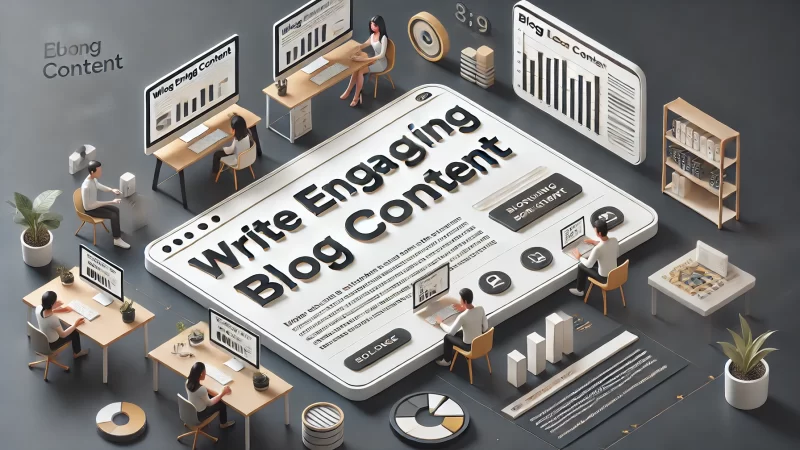
Engaging blog content is essential for driving traffic and generating income. When you focus on creating valuable, reader-centric content, you increase your chances of attracting a loyal audience. I suggest understanding your audience’s needs and delivering solutions through well-structured, SEO-optimized posts. This combination ensures your blog stands out and converts visitors into customers.
To make a blog for money, your content needs to engage readers and keep them coming back. This can be achieved by writing in a conversational tone, making complex ideas easy to understand, and optimizing for SEO. Great content not only brings in traffic but also positions you as an authority in your niche, increasing your blog’s earning potential.
Understanding Your Readers’ Needs And Pain Points
Before you start writing, I recommend spending time getting to know your readers. What challenges are they facing? I’ve found that understanding their pain points allows you to create blog posts that offer genuine solutions. This type of content builds trust, making your readers more likely to engage with your blog and click on affiliate links or ads.
Surveys and comments are invaluable tools for learning about your audience. I often use them to gather insights directly from readers. When you understand their frustrations, you can create blog posts that directly address their concerns, offering helpful advice that they will appreciate—and possibly share with others.
I suggest focusing on actionable content. Readers want quick, practical solutions they can apply immediately. When you provide easy-to-follow steps or resources that solve their problems, they’re more likely to return to your blog. I also advise using real-life examples to demonstrate how your advice can work in practice.
It’s essential to engage with your audience in the comments section. Responding to questions or feedback not only strengthens your community but also gives you a better understanding of what topics resonate. I’ve noticed that this two-way interaction keeps readers invested in your blog, which can translate to higher earnings.
I recommend using empathy when writing your posts. Imagine yourself in your readers’ shoes, and write with the goal of helping them succeed. When you show that you care about their problems, you foster trust, and trust leads to higher conversion rates, whether through product recommendations or ad clicks.
Tips For Writing SEO-Optimized Blog Posts
Writing blog posts that rank high in search engines is crucial for attracting organic traffic. I recommend focusing on long-tail keywords—specific, low-competition phrases that match the intent of your target audience. Using tools like Google Keyword Planner helps you identify the right keywords to drive traffic to your blog.
I suggest placing your primary keyword in the title, meta description, and throughout the post naturally. Overloading your text with keywords can hurt readability, so I advise keeping the flow natural. I find that when posts are well-optimized and easy to read, they tend to perform better in search engines and engage readers more effectively.
Headings and subheadings should include secondary keywords to help break up your content and improve SEO. I’ve learned that search engines prioritize well-structured content. By organizing your blog post into clear sections with relevant keywords, you not only improve search engine rankings but also enhance the user experience.
Internal linking is another strategy I use to boost SEO. Linking to other related posts on your blog helps distribute SEO value and encourages readers to spend more time on your site. More time on site means increased ad revenue or a higher chance of them making a purchase through an affiliate link.
Don’t forget to optimize images as well. I recommend using descriptive alt text that includes your keyword. This boosts your SEO and ensures that your images contribute to the overall user experience. Compressing images to ensure fast loading times is essential, as slow blogs lose traffic—and money.
How To Structure Blog Posts For Better Readability
I believe that readability plays a huge role in the success of your blog content. If your posts are hard to read, visitors won’t stay long. I suggest using short paragraphs, bullet points, and subheadings to break up text, making it easier for readers to digest. This improves the user experience and encourages them to engage with your content.
Use a clear introduction, body, and conclusion format. In the introduction, I advise you to hook readers with a question or interesting fact that aligns with their interests. The body should deliver value-packed information in a logical order, while the conclusion ties everything together and includes a call to action (CTA) to guide readers on what to do next.
Lists and bullet points help present information clearly. I’ve noticed that readers love skimmable content, so using these elements makes your posts more digestible. When you make it easy for visitors to scan your blog, they’re more likely to stay on the page longer, improving engagement and increasing the likelihood of earning income.
Subheadings play a key role in keeping readers on track. I recommend using descriptive subheadings that give a clear indication of what’s coming next. This not only improves readability but also enhances SEO, as search engines favor well-structured content with appropriate headers.
Finally, I suggest incorporating visuals like images, infographics, or videos to break up long chunks of text. Visual content not only improves engagement but also provides additional value by presenting information in a different format. Readers who prefer visuals will appreciate this, and it can help drive more traffic to your blog.
Crafting Catchy Headlines That Drive Traffic
A compelling headline can make the difference between a reader clicking on your blog post or moving on to the next search result. I recommend using power words and emotion in your headlines to grab attention. For example, phrases like “Proven,” “Ultimate,” or “Step-by-Step” create a sense of authority and urgency, enticing readers to click.
I’ve learned that including numbers in headlines can boost engagement. Readers are naturally drawn to lists and step-by-step guides, so I suggest headlines like “7 Simple Ways to Monetize Your Blog” or “5 Essential Tools for Blogging Success.” Numbers create a promise of specific, actionable content that readers appreciate.
Your headline should also clearly communicate the benefit of reading the post. I find that readers are more likely to click on a blog post if they know they will learn something valuable. Phrases like “How to,” “Ultimate Guide,” or “Top Tips” promise practical advice, which appeals to readers looking for solutions.
Using curiosity in headlines is another tactic I recommend. When you hint at a benefit without fully revealing it, readers feel compelled to click through and discover the rest. For example, a headline like “Discover the One Strategy That Doubles Blog Income” creates intrigue while still communicating value.
Lastly, I advise testing different headlines to see which resonates best with your audience. Tools like CoSchedule’s Headline Analyzer can help you craft titles that score high on engagement and SEO. Sometimes, small tweaks to wording or structure can significantly impact your blog’s traffic and overall success.
Optimizing Blog Design For A Better User Experience
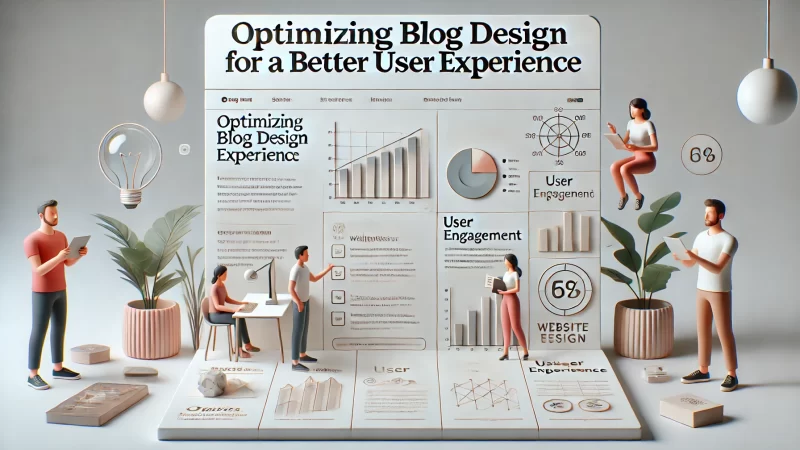
Blog design plays a crucial role in keeping visitors on your site and encouraging them to explore your content further. I recommend focusing on a clean, intuitive layout that prioritizes easy navigation and fast load times. The easier your blog is to use, the more likely visitors are to stay and engage with your monetization efforts.
A well-designed blog also builds trust. When readers see a professional-looking site, they’re more likely to view you as an authority. I suggest investing time into choosing a theme that reflects your niche while keeping the user experience at the forefront. A good design improves both traffic and conversions.
Best Practices For Creating Mobile-Friendly Blog Designs
With more people browsing the web on mobile devices, I believe having a mobile-friendly blog design is essential. I recommend using a responsive theme that adjusts automatically to different screen sizes. This ensures that your blog looks great whether someone is viewing it on a desktop, tablet, or smartphone.
A clean layout is key to mobile optimization. I suggest using minimal elements and large fonts that are easy to read on small screens. A cluttered design frustrates mobile users, leading them to leave your site quickly. I’ve found that simplifying your design can significantly improve mobile user engagement.
Navigation is another critical factor. I advise placing a simple, easy-to-use menu at the top of your blog that works well on mobile devices. Dropdowns can become tricky on mobile, so consider using a hamburger menu for better navigation. Ensuring your readers can easily find what they’re looking for helps keep them on your blog longer.
I also recommend testing your blog’s mobile performance regularly. Tools like Google’s Mobile-Friendly Test can help you identify areas where your design needs improvement. I’ve noticed that even small tweaks, like adjusting button sizes or improving load times, can make a big difference in user satisfaction.
Fast load times are particularly important for mobile users. I suggest using a caching plugin and optimizing images to ensure your blog loads quickly. Mobile users are often on slower connections, so a fast-loading site keeps them from bouncing away, increasing your chance of earning income from their visit.
How To Choose The Right Theme For Your Blog
Choosing the right theme sets the tone for your blog’s design and functionality. I recommend selecting a theme that aligns with your niche while offering flexibility for growth. Themes with clean, minimalist designs tend to work best for most bloggers, as they provide a professional look without overwhelming the user.
Customization options are essential. I advise looking for a theme that allows you to change colors, fonts, and layouts to match your brand. A theme that’s too rigid may limit your ability to differentiate your blog. I’ve found that bloggers who can easily update their design as their brand evolves often see better engagement.
Make sure the theme you choose is optimized for SEO. I recommend checking whether the theme has clean, lightweight code that won’t slow down your blog. Themes that are SEO-friendly give you a better chance of ranking higher in search results, which directly impacts how much money you can make from your blog.
I also suggest ensuring that your theme is compatible with important plugins. Some themes may not work well with certain plugins, limiting your ability to add functionality. Before purchasing or installing a theme, I always check reviews and compatibility to avoid any issues down the line.
Lastly, I recommend choosing a theme that offers strong customer support. If you encounter technical difficulties, having access to a responsive support team can save you time and frustration. A well-supported theme ensures that your blog runs smoothly, giving you more time to focus on creating content and growing your audience.
Using Visuals To Enhance User Engagement
I believe that visuals play a significant role in keeping your audience engaged. Images, infographics, and videos not only break up long blocks of text but also provide additional value. I recommend incorporating high-quality, relevant visuals that complement your content, making it easier for readers to absorb information.
I suggest using tools like Canva to create custom graphics that match your brand. Custom visuals can help you stand out in a crowded niche and give your blog a professional feel. When readers see well-designed images, they’re more likely to share your posts, which boosts your reach and potential income.
Infographics are particularly effective for summarizing complex information. I’ve found that readers love visual representations of data, especially when it comes to tutorials or how-tos. Infographics are not only shareable but also help drive traffic to your blog, increasing your chances of making money through ads or affiliate links.
Videos are another powerful engagement tool. Embedding relevant videos in your posts adds an interactive element that keeps readers on your page longer. I recommend creating short, informative videos that complement your blog content. The more time readers spend on your site, the more likely they are to engage with your monetization strategies.
Lastly, don’t forget to optimize your visuals for SEO. I advise using descriptive file names and alt text for all images, as this helps search engines index them properly. Optimized visuals can drive additional traffic from image searches, bringing more visitors to your blog and increasing your earning potential.
Proven Monetization Strategies For Your New Blog
Once your blog is set up, the next critical step is monetization. I believe there are several effective ways to earn money from your blog. Whether it’s through affiliate marketing, ad networks, selling products, or collaborations, you’ll need to focus on diversifying your revenue streams. This approach helps maximize your earning potential.
I suggest starting with monetization strategies that align with your blog’s content and audience. For instance, if your readers value recommendations, affiliate marketing could be highly effective. On the other hand, if you have products or services to offer, direct sales can also be an immediate source of income. The key is to match the right strategy to your niche.
How To Earn Through Affiliate Marketing On Your Blog
Affiliate marketing is one of the easiest and most profitable ways to monetize your blog. Essentially, I suggest you promote products or services relevant to your audience, and when readers make a purchase using your unique affiliate link, you earn a commission. This strategy works particularly well if your blog offers helpful reviews or tutorials.
To start, I recommend signing up for reputable affiliate programs such as Flexoffers or ShareASale. These platforms offer a wide range of products across different industries. Choosing products that align with your content is critical; I’ve found that readers are more likely to trust your recommendations when they see a clear connection.
I also advise you to weave affiliate links naturally into your content. Instead of overly promoting products, I suggest incorporating links where they provide additional value to your readers. For instance, in a blog post about fitness tips, you can mention and link to fitness equipment you personally recommend and use.
One thing I’ve noticed is that transparency builds trust. Always disclose when a link is an affiliate link. Readers appreciate honesty, and when they trust your recommendations, they are more likely to make purchases. This trust can increase your conversions and, ultimately, your earnings from affiliate marketing.
Lastly, I recommend tracking the performance of your affiliate links. By using tools like Pretty Links or ClickMagick, you can monitor which products generate the most interest and clicks. This data helps you refine your strategy and focus on promoting products that truly resonate with your audience.
How To Use Ad Networks To Maximize Your Blog Revenue
Ad networks like Google AdSense can be another great way to monetize your blog. I’ve seen bloggers earn steady passive income by displaying ads on their sites. The more traffic your blog generates, the more potential there is for ad clicks, leading to higher revenue. However, ad placement and optimization are key to maximizing earnings.
To begin, I recommend applying for Google AdSense once your blog has consistent traffic. AdSense is user-friendly and places relevant ads on your blog automatically. Alternatively, I’ve found that other platforms like Hilltopads or Popads can offer higher payouts for bloggers with significant traffic.
Be mindful of your ad placement. I suggest placing ads in visible but non-intrusive areas, such as within the sidebar or between blog posts. Poorly placed ads can frustrate readers, causing them to leave your site. A balanced approach ensures your readers stay engaged while still contributing to your ad revenue.
One tip I advise is testing different ad formats. You may experiment with text, image, or video ads to see which performs better on your blog. I’ve noticed that some readers respond more positively to certain types of ads, and adjusting these formats can significantly boost your overall earnings.
Additionally, keep an eye on your blog’s load speed. I know that too many ads can slow down your site, negatively impacting user experience and SEO. I recommend using tools like Google PageSpeed Insights to monitor your blog’s performance and ensure your ads aren’t compromising the quality of the user experience.
Selling Products And Services Directly From Your Blog
Another powerful way to monetize your blog is by selling your own products or services. I’ve seen bloggers successfully turn their expertise into profitable digital products, such as eBooks, courses, or consulting services. This strategy allows you to have full control over pricing and profit margins, making it a lucrative option.
If you have knowledge to share, I suggest creating an eBook or an online course related to your niche. For instance, if your blog focuses on personal finance, offering a course on budgeting or investing could resonate well with your audience. Selling digital products can also provide recurring income with minimal ongoing effort.
Physical products can also be profitable if they align with your brand. I recommend starting with print-on-demand services, which allow you to sell products like t-shirts or mugs without holding inventory. These services fulfill orders directly, so you can focus on promoting the products through your blog.
I advise promoting your products in blog posts, newsletters, and social media. Your readers trust your content, and by offering them solutions in the form of products or services, you can create an additional revenue stream. I’ve found that offering discounts or limited-time deals can encourage purchases and boost your income.
Finally, don’t underestimate the value of offering consulting or coaching services. I’ve seen bloggers charge premium rates for one-on-one sessions or personalized advice, especially in niches like business, wellness, or marketing. This service can provide a direct and immediate source of income for your blog.
Setting Up Sponsored Posts And Collaborations
Sponsored posts are another effective way to monetize your blog. Companies pay you to write posts that promote their products or services. I’ve noticed that as your blog grows in authority and traffic, brands will approach you for these opportunities. Sponsored collaborations can be a steady source of income once you build your reputation.
I suggest starting by reaching out to brands that align with your niche. You can offer to write reviews, tutorials, or features in exchange for payment. I’ve learned that it’s important to choose collaborations that are authentic to your brand to maintain your readers’ trust. Sponsored posts should offer value, not just promotion.
When setting rates for sponsored posts, I recommend considering factors like your blog’s traffic, engagement rates, and the type of content required. You can negotiate higher rates based on these factors. I find that bloggers who consistently engage their audience can command higher fees for their sponsored content.
In addition to sponsored posts, you can explore affiliate partnerships where brands pay you a commission for each sale generated from your blog. I’ve seen bloggers successfully combine both strategies to create multiple income streams, maximizing their earnings potential.
Finally, make sure you’re transparent with your readers about sponsored content. I suggest clearly labeling sponsored posts to maintain credibility. Your audience will appreciate the honesty, and it ensures you stay in compliance with advertising guidelines. This trust factor is crucial for maintaining long-term relationships with both brands and readers.
Leveraging Social Media To Drive Traffic And Income

Social media is a powerful tool for promoting your blog and driving traffic. I’ve found that a well-crafted social media strategy can help you reach new audiences and increase your blog’s visibility. The more people you can bring to your blog from platforms like Pinterest or Instagram, the higher your potential earnings.
To get the most out of social media, I suggest focusing on the platforms that best align with your blog’s content and audience. Each platform offers unique ways to engage with your readers and drive traffic back to your blog.
Building A Social Media Strategy That Works
Creating a social media strategy is essential for growing your blog’s traffic. I recommend starting by identifying where your audience spends most of their time. For example, if your blog is about interior design, platforms like Instagram and Pinterest are ideal for sharing visual content and driving traffic to your blog.
It’s important to maintain consistency. I suggest posting regularly and creating content that aligns with your blog’s voice and tone. I’ve found that sharing blog updates, tips, and behind-the-scenes content helps build a stronger connection with your followers, encouraging them to visit your blog more frequently.
Engaging with your followers is crucial. I recommend responding to comments, asking questions, and interacting with your audience. This two-way conversation makes your readers feel valued, increasing their likelihood of visiting your blog and purchasing products or clicking on affiliate links.
I also suggest using analytics tools to track which posts perform the best. You can then adjust your content strategy to focus on the types of posts that generate the most engagement and clicks. I’ve learned that using data to guide your strategy ensures you’re spending time on the most effective social media tactics.
Finally, I advise incorporating social sharing buttons on your blog. Make it easy for readers to share your posts directly to their social media profiles. This helps increase the visibility of your blog and can lead to more traffic, which ultimately enhances your monetization efforts.
How To Use Pinterest For Blog Traffic And Sales
Pinterest is a goldmine for bloggers who want to drive traffic and increase sales. I suggest creating eye-catching pins that link back to your blog posts. Unlike other social media platforms, Pinterest acts as a search engine, making it a valuable tool for bloggers in niches like DIY, food, travel, and lifestyle.
I’ve found that using rich pins helps boost visibility on Pinterest. Rich pins display more information, such as prices or availability, directly on the pin, which increases the chances of getting clicks. I recommend using tools like Canva to design professional-looking pins that grab attention.
Consistency is key on Pinterest. I suggest pinning daily, either manually or by using a scheduling tool like Tailwind. Regular pinning helps your content stay fresh and visible on Pinterest, driving more users to your blog over time. This increased traffic can lead to higher earnings from ad networks or affiliate marketing.
I advise creating multiple pins for each blog post, each with different designs and headlines. This helps you reach a broader audience and increases the likelihood of your content being discovered by new users. I’ve seen bloggers significantly increase their traffic by experimenting with different pin styles and formats.
Lastly, don’t forget to track your Pinterest analytics. Monitoring which pins get the most clicks and engagement allows you to refine your strategy. I recommend focusing on the topics and visuals that resonate most with your Pinterest audience, driving even more traffic to your blog.
Why Instagram Is Key For Building Brand Awareness
Instagram is a great platform for building brand awareness and driving traffic to your blog. I suggest using Instagram’s visual focus to your advantage by sharing high-quality images and short, engaging captions that lead readers back to your blog. Instagram Stories and Reels are also effective for increasing engagement.
Consistency matters on Instagram too. I advise creating a content calendar to ensure you’re posting regularly. Whether it’s daily posts, weekly stories, or live Q&As, regular interaction with your followers helps keep your blog top of mind, driving more visitors to your site over time.
I’ve noticed that using hashtags effectively can expand your reach. I recommend researching popular hashtags in your niche and incorporating them into your posts. Hashtags help new users discover your content, leading to potential new readers and blog subscribers.
Engagement is crucial on Instagram. I suggest responding to comments, liking followers’ posts, and participating in conversations. The more you interact, the more you’ll build a loyal community around your blog. A strong community increases your credibility and encourages readers to explore your monetized content.
Lastly, I advise using Instagram analytics to track the performance of your posts. This data helps you identify which types of content your audience enjoys most, so you can continue delivering value while driving traffic to your blog. The more engaged your Instagram followers, the better your chances of turning them into blog readers and customers.
Building An Email List To Increase Blog Earnings
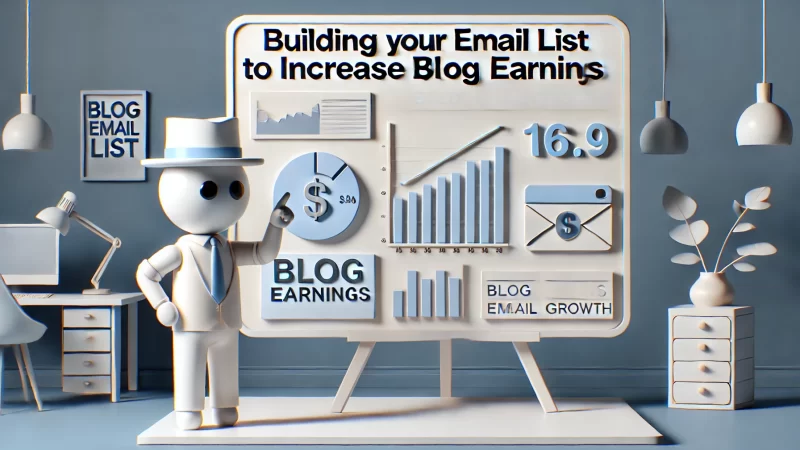
Building an email list is one of the most powerful strategies for increasing blog earnings. I believe that an engaged email list gives you direct access to your readers, allowing you to nurture relationships and drive conversions. By creating valuable content and offers, you can turn subscribers into paying customers over time.
I recommend starting your email list early, even if your blog is new. This ensures that you are building a community that will grow with your blog. Over time, as your audience becomes more invested in your content, they will be more likely to support your monetization strategies, such as affiliate marketing or product sales.
How To Set Up Effective Lead Magnets
Lead magnets are the cornerstone of growing an email list. I suggest offering something valuable, such as a free eBook, checklist, or resource guide, in exchange for your readers’ email addresses. These incentives give readers a reason to subscribe and help you build your list faster.
I recommend making your lead magnet highly relevant to your blog’s niche. If your blog is about fitness, offering a free workout plan would align perfectly with your audience’s interests. This ensures the quality of your subscribers and increases the likelihood of conversions down the line.
One thing I’ve noticed is that lead magnets should solve a specific problem. Readers are more likely to opt in if they believe your offer will provide an immediate solution to their challenges. I suggest keeping your lead magnet concise and actionable to maximize its effectiveness.
To make your lead magnet more appealing, I advise adding a compelling call-to-action (CTA) on your blog. Place it strategically on your homepage, within blog posts, or even in pop-up forms. I’ve found that clear and enticing CTAs can significantly increase your conversion rate.
Lastly, I recommend testing different lead magnet offers to see which one resonates best with your audience. You may notice that certain formats, such as templates or tutorials, perform better than others. Continuously refining your offers will help you attract more subscribers and grow your list.
Using Newsletters To Build Loyal Audiences
Newsletters are an excellent way to keep your subscribers engaged and nurture loyalty. I suggest sending regular updates, such as new blog posts, exclusive offers, or personal stories, to build a connection with your audience. Consistency is key to maintaining interest and keeping readers invested in your content.
I recommend crafting newsletters that provide value to your readers. Instead of focusing solely on promotions, share insights, tips, or behind-the-scenes content. This approach builds trust and keeps your subscribers looking forward to your emails, which increases the chances of them purchasing products or clicking on affiliate links.
Personalization is a powerful tool in email marketing. I’ve found that using the subscriber’s name in the email and tailoring content based on their preferences can boost engagement. The more relevant your content, the more likely your audience will stay subscribed and take action.
I advise you to keep your newsletters visually appealing and easy to read. Using a clean, organized layout with images, bullet points, and short paragraphs improves readability. I’ve noticed that well-designed newsletters tend to perform better and drive more traffic back to your blog.
It’s important to track your newsletter performance. I recommend analyzing open rates, click-through rates, and unsubscribes to see what resonates with your audience. This data helps you refine your email strategy, ensuring your newsletters remain effective in growing your blog earnings.
How To Automate Email Campaigns For Steady Sales
Automating your email campaigns can significantly improve efficiency and ensure consistent engagement with your audience. I suggest setting up drip campaigns, which are a series of automated emails sent over time. These campaigns guide subscribers through a journey, from introduction to purchasing, without requiring constant manual effort.
I recommend using email marketing platforms like Mailchimp or ConvertKit to automate your campaigns. These tools allow you to create sequences based on subscriber actions, such as signing up for a lead magnet or clicking on a link. I’ve found that automating these processes frees up time to focus on creating content.
When creating automated campaigns, I advise focusing on delivering value first. Start by welcoming new subscribers and sharing helpful resources or blog posts. Gradually introduce your monetization offers, such as affiliate products or services. This approach builds trust before asking for a purchase.
I suggest segmenting your email list based on interests or behaviors. By sending targeted content to different segments, you increase the relevance of your emails. For example, I’ve seen higher engagement when offering tailored recommendations based on past purchases or browsing behavior.
Finally, I believe in regularly reviewing and optimizing your automated campaigns. Analyzing open rates, click-through rates, and conversions will help you refine your emails. Over time, you’ll be able to increase the effectiveness of your campaigns, generating steady sales and blog revenue.
Tracking And Analyzing Blog Performance For Growth
Tracking your blog’s performance is essential for long-term growth and maximizing earnings. I recommend consistently analyzing key metrics to understand how your blog is performing. This data allows you to make informed decisions, refine your content strategy, and identify opportunities for improvement in your monetization efforts.
By focusing on performance analytics, you can optimize your blog for better traffic, higher engagement, and ultimately, more revenue. I suggest using tools like Kissmetrics and affiliate tracking platforms to monitor your blog’s progress and growth over time.
Top Blogging Metrics You Should Be Tracking
Tracking the right metrics is crucial to understanding your blog’s success. I recommend focusing on key performance indicators (KPIs) such as traffic, bounce rate, and conversion rate. Traffic measures the number of visitors, while bounce rate indicates how many leave without engaging. Together, these metrics provide insights into your blog’s overall health.
I also suggest keeping a close eye on page views. I’ve noticed that blogs with high page views often generate more ad revenue, as advertisers value exposure. Regularly monitoring your page views helps you identify which posts perform best and attract the most traffic.
Engagement metrics, like time on site and pages per session, are equally important. I recommend focusing on these indicators to understand how well your content is resonating with readers. If users are spending more time on your blog and visiting multiple pages, you’re more likely to convert them into loyal readers or customers.
Tracking conversion rates is essential if you’re monetizing through products or affiliate marketing. I advise you to analyze how many visitors take the desired action, such as signing up for your email list or making a purchase. A low conversion rate may indicate the need to optimize your CTAs or content.
Lastly, I suggest tracking your revenue metrics. Whether through ads, affiliate marketing, or product sales, it’s vital to know how much income each monetization method generates. This allows you to focus on the strategies that bring the highest returns and improve your blog’s overall profitability.
How To Use Google Analytics To Improve Traffic
Google Analytics is one of the most valuable tools for tracking and improving blog traffic. I suggest installing Google Analytics as soon as your blog launches to begin gathering data. The insights provided can help you refine your content strategy, optimize user experience, and increase your overall traffic.
I recommend regularly reviewing your top-performing pages. These pages often attract the most visitors and have the highest engagement. By analyzing their performance, I’ve learned which types of content resonate best with readers. This allows you to create more content tailored to their interests, driving additional traffic.
Another key feature of Google Analytics is the traffic source report. I suggest using this report to identify where your visitors are coming from, whether it’s organic search, social media, or referral traffic. Understanding your traffic sources helps you focus on what’s working and adjust strategies for underperforming channels.
I advise paying attention to the behavior flow report. This report shows how users navigate through your blog, allowing you to identify common exit points. If you notice readers leaving after a specific page, it may be worth optimizing that content or adding stronger internal links to keep them on your site.
Lastly, I recommend using Google Analytics to monitor mobile traffic. I’ve noticed that mobile users now make up a significant portion of blog visitors. If mobile traffic is high but engagement is low, it may indicate the need to improve your blog’s mobile experience, such as optimizing load times or adjusting design elements.
Tools For Tracking Your Affiliate And Ad Income
Tracking affiliate and ad income is crucial for understanding the effectiveness of your monetization strategies. I suggest using dedicated tools to monitor your earnings and optimize your efforts. These tools provide detailed insights into what’s working and help you make data-driven decisions to increase revenue.
For affiliate income, I recommend using platforms like ShareASale or Awin, which offer built-in tracking tools. These platforms show you how many clicks your links are getting and how many conversions result from those clicks. I’ve found that tracking these metrics helps identify which products resonate most with readers.
To track ad income, I suggest using Google AdSense’s reporting dashboard. This tool provides real-time data on ad impressions, clicks, and earnings. Monitoring these metrics allows you to adjust your ad placements or formats to maximize revenue. I’ve seen bloggers improve their ad earnings by optimizing based on performance.
Using a tool like Pretty Links can help you track affiliate link performance more effectively. Pretty Links allows you to shorten, customize, and monitor every click on your affiliate links. I’ve found that having this level of control over affiliate tracking helps you identify which links and strategies work best for your audience.
I also recommend regularly reviewing your overall earnings in comparison to your blog’s traffic. If your income isn’t scaling with your traffic growth, you may need to refine your monetization strategy. I suggest testing different ad placements or affiliate products to see which combinations drive the highest returns.
Finally, consider integrating your tracking tools with Google Analytics. By combining data from multiple sources, you get a comprehensive view of how your blog is performing across various revenue streams. This holistic approach helps you make informed decisions that lead to increased earnings over time.
Common Mistakes To Avoid When Starting A Blog For Money
Starting a blog to make money is exciting, but it’s easy to make mistakes along the way. I believe avoiding common pitfalls can save you time and frustration, keeping your blog on the right path to profitability. Learning from others’ errors helps you stay focused on what truly drives success.
I recommend identifying potential missteps early, so you can avoid them. From overloading your blog with ads to picking the wrong niche, some decisions can impact your blog’s long-term growth. Addressing these common mistakes allows you to build a blog that not only attracts readers but also generates income consistently.
Why You Should Avoid Overloading With Ads
Overloading your blog with ads might seem like an easy way to earn money, but it can backfire. I’ve noticed that too many ads frustrate readers, leading them to abandon your site. This increases your bounce rate, which negatively impacts your SEO and ultimately reduces your long-term earning potential.
I suggest balancing the number of ads on your blog. Instead of cramming in as many as possible, focus on strategically placing ads where they will be most effective. For example, sidebar ads or ads between blog posts tend to be less intrusive, allowing readers to engage with your content without feeling overwhelmed.
Another issue I’ve seen is slow site speed due to too many ads. Ads can slow down your blog’s loading time, leading visitors to click away before they even see your content. I advise testing your site speed regularly and limiting the number of ads to ensure your blog loads quickly, keeping your readers engaged.
I recommend focusing on high-quality ads that are relevant to your audience. When you place ads that match your blog’s niche, readers are more likely to click, improving your overall ad revenue. I’ve found that quality ads convert better than quantity, so don’t overwhelm your readers with irrelevant ads.
Lastly, I advise diversifying your income streams. Relying solely on ads can limit your earning potential. Instead, consider affiliate marketing, sponsored posts, or selling digital products. These additional revenue sources reduce the need to overload your blog with ads, enhancing the user experience and keeping readers coming back.
How To Prevent Content Burnout In The First 30 Days
Content burnout is a common challenge for new bloggers, especially those eager to make money quickly. I suggest pacing yourself when creating content. Trying to publish too many posts in a short period can lead to burnout, which may cause you to lose motivation and stop posting altogether.
One strategy I recommend is setting a realistic content schedule. Instead of aiming for daily posts, consider starting with one or two high-quality blog posts per week. I’ve found that consistency is more important than frequency. A steady posting schedule keeps your readers engaged and reduces the pressure on you to produce constantly.
I also advise planning your content ahead of time. Creating a content calendar can help you stay organized and focused on your goals. I’ve noticed that having a clear roadmap makes the writing process smoother and prevents the stress of coming up with ideas at the last minute.
It’s important to take breaks when needed. Blogging is a long-term game, and I believe giving yourself time to recharge prevents burnout. I suggest stepping away from your blog occasionally to refresh your creativity, allowing you to come back with new ideas and energy.
Lastly, I find that outsourcing some tasks can reduce the burden. If you feel overwhelmed, I recommend hiring freelance writers or virtual assistants to handle some aspects of your blog, such as social media management or editing. This allows you to focus on what you love most—creating valuable content for your readers.
Mistakes To Avoid When Selecting A Blog Niche
Choosing the wrong niche can set your blog up for failure before you even start. I believe it’s crucial to select a niche that not only interests you but also has a proven audience. Blogging in a niche you’re not passionate about can lead to burnout, while a niche with no audience won’t generate traffic or income.
I recommend avoiding overly saturated niches unless you have a unique angle. Popular topics like travel or fitness can be highly competitive, making it difficult for new bloggers to stand out. I’ve found that focusing on a specific sub-niche, like sustainable travel or fitness for seniors, gives you a better chance of success.
Another mistake I see is choosing a niche without considering its profitability. I suggest researching potential monetization options within your chosen niche. If you can’t identify affiliate programs, product opportunities, or services to offer, you may struggle to make money from your blog.
I’ve noticed that some bloggers choose a niche they think will be profitable but lack personal interest. This often leads to inconsistent content creation, as the blogger loses motivation. I advise selecting a niche you’re genuinely passionate about, as this will keep you excited about writing and building your blog.
Lastly, avoid niches that are too narrow. While it’s important to have a clear focus, choosing a niche that’s too specific may limit your audience. I suggest finding a balance between being niche-specific and having enough breadth to appeal to a wide range of readers and potential customers.
Why Patience And Persistence Pay Off In Blogging Success
Blogging for money requires patience and persistence. I’ve learned that success rarely happens overnight, but with consistent effort, it’s possible to build a profitable blog. Many new bloggers get discouraged when they don’t see immediate results, but I believe staying the course is essential for long-term growth.
I recommend setting realistic expectations when starting your blog. It takes time to build traffic, gain loyal readers, and earn money. By staying focused on your goals and making gradual progress, you’ll eventually see the fruits of your labor. Persistence is what separates successful bloggers from those who give up too soon.
The Importance Of Setting Realistic Financial Goals
Setting realistic financial goals is crucial when building a blog for money. I suggest starting with small, achievable targets to avoid feeling overwhelmed. For example, aiming for your first $100 in affiliate earnings can be more motivating than expecting to earn thousands in your first month.
I recommend breaking your financial goals into milestones. You may set a goal to increase ad revenue by 10% each month or double your affiliate income within six months. I’ve found that these incremental goals keep you focused and motivated as you work towards larger financial objectives.
It’s important to be patient with your blog’s growth. I advise against expecting to make significant money right away. It can take months or even a year to see substantial earnings. However, I believe that by sticking with your financial goals, you’ll start seeing a steady increase in your blog’s income.
I also recommend regularly reviewing and adjusting your goals. As your blog grows, you may find that certain monetization methods perform better than others. By being flexible with your financial goals, you can focus on strategies that work and improve your overall earnings.
Finally, I suggest tracking your progress. Use tools like Google Analytics and affiliate tracking platforms to monitor your income and traffic growth. Seeing progress, even if it’s slow, will keep you motivated to continue working towards your financial goals and building a profitable blog.
How To Stay Motivated When Results Are Slow
Blogging success doesn’t happen overnight, and it’s easy to feel discouraged when results are slow. I’ve learned that staying motivated during these times is key to long-term success. I suggest focusing on small wins, like gaining new subscribers or improving your SEO rankings, to keep your momentum going.
I recommend celebrating these small victories. Each new reader, comment, or social media share is a sign that your blog is growing. Acknowledging these milestones reminds you that progress is being made, even if income growth is slow at first.
Another tip I suggest is connecting with other bloggers in your niche. Engaging with a community of like-minded individuals provides support and inspiration. I’ve found that sharing experiences, challenges, and wins with fellow bloggers helps you stay motivated during difficult times.
Setting short-term goals can also keep you motivated. I advise breaking larger tasks into smaller, more manageable ones. For instance, instead of aiming for 100 new subscribers in a month, focus on gaining 5 subscribers a week. Reaching these smaller goals keeps you feeling accomplished and driven.
Finally, I recommend focusing on the bigger picture. Building a successful blog takes time, and slow periods are part of the process. I’ve seen many bloggers thrive by staying consistent, learning from setbacks, and continuously improving their strategies. The results will come if you stay patient and persistent.
How To Scale Your Blog After The First Month
Once you’ve established your blog in the first month, it’s time to think about scaling. I suggest focusing on expanding your content strategy by adding new topics or formats, such as videos or podcasts. Diversifying your content can attract a broader audience and increase your blog’s visibility, leading to more income opportunities.
I recommend optimizing your existing content for SEO. Updating older posts with new keywords, internal links, and improved readability helps drive more traffic over time. I’ve seen significant traffic boosts from bloggers who continuously refine their content to match current search trends and user preferences.
Collaborating with other bloggers is another strategy I’ve found effective. Guest posting or cross-promoting each other’s content helps expose your blog to new audiences. I recommend reaching out to bloggers in complementary niches to form partnerships that benefit both parties.
I also suggest scaling your email marketing efforts. By creating more lead magnets, segmenting your email list, and automating email sequences, you can nurture subscribers into loyal readers. I’ve found that growing an engaged email list directly correlates to higher earnings from product launches or affiliate marketing.
Lastly, consider investing in paid advertising. Once you’ve built a solid foundation, using Facebook Ads, Google Ads, or Pinterest Ads can accelerate your blog’s growth. I advise starting with a small budget and experimenting with different ad types to find what works best for driving traffic and generating conversions.
Frequently Asked Questions (FAQ)
What is the best way to monetize a blog in the first 30 days?
I suggest focusing on affiliate marketing and ad networks, as they are the easiest to implement for beginners. Affiliate marketing allows you to promote relevant products and earn a commission on sales, while ad networks like Google AdSense can help generate passive income through clicks.
How can I find a profitable blog niche?
I recommend choosing a niche that combines your passion with profitability. Start by researching popular topics, evaluating the competition, and ensuring there are enough monetization opportunities, such as affiliate programs or products to sell. Selecting a niche that has consistent audience demand is crucial for success.
How long does it take to start making money from a blog?
While every blog is different, I’ve found that it usually takes around 3 to 6 months of consistent effort to start generating noticeable income. This time frame can be shorter if you have a well-planned content strategy, strong SEO, and focused monetization efforts like affiliate marketing.
How do I increase traffic to my blog?
I suggest optimizing your blog posts for SEO by using relevant keywords, improving site speed, and regularly updating content. Additionally, sharing your posts on social media platforms, engaging with other bloggers, and building backlinks can significantly boost your blog’s visibility and traffic.
How many blog posts should I publish each week?
I recommend starting with one or two high-quality posts per week, especially when you’re just beginning. Consistency is more important than quantity, and over time, you can gradually increase the number of posts as you become more comfortable with content creation and grow your audience.
What are the biggest mistakes new bloggers make?
I’ve noticed that new bloggers often overload their sites with ads, choose the wrong niche, or expect to make money too quickly. I advise focusing on creating valuable content, setting realistic goals, and avoiding burnout by sticking to a manageable content creation schedule.





